Adult criminal court statistics in Canada, 2013/2014
Archived Content
Information identified as archived is provided for reference, research or recordkeeping purposes. It is not subject to the Government of Canada Web Standards and has not been altered or updated since it was archived. Please "contact us" to request a format other than those available.
by Ashley Maxwell
[Highlights] [Full article in PDF]
- Completed adult criminal court cases decrease in 2013/2014
- Most completed adult criminal court cases involve non-violent offences
- Majority of adult court cases involve young adults
- Almost two thirds of all completed adult cases result in finding of guilt
- Cases involving violent offences result in guilty finding less often than non-violent cases
- Probation most common sentence imposed in adult criminal court
- Most custody sentences less than 6 months
- Case processing times increase
- Completed adult criminal court cases in 2013/2014 at a glance
- Survey description
- Detailed data tables
- References
- Notes
The criminal court system consists of multiple court levels with responsibility shared between federal, provincial and territorial governments. Courts are responsible for making decisions regarding the culpability of those accused of committing a criminal offence, and determining an appropriate sentence for those who are found or plead guilty (Department of Justice Canada 2015). The United Nations has indicated that reliable and comprehensive statistics on criminal justice allows policy makers and government officials to accurately assess and monitor the conditions, circumstances and trends of the justice system, as well as the well-being and social impact of public expenditures and policies (United Nations Office on Drugs and Crime 2006). There is a need for robust justice indicators related to Canadian criminal courts, as they are essential tools to help make the criminal justice system more transparent and accountable (Dandurand et. al 2015).
This Juristat utilizes data from the 2013/2014 Integrated Criminal Court Survey (ICCS), and presents information on the characteristics of criminal court cases involving adults (18 years and older).Note 1 It presents several key indicators of the adult criminal court process, and focuses on the number of completed cases (including the most common types of offences), the decisions made in cases, as well as the types of sentences that are imposed on accused persons who are found guilty. In addition, this article briefly presents results by age and sex of the accused, median sentence lengths, as well as the amount of time it takes to process completed adult criminal court cases and the factors which may influence court timeliness.
Data presented in this article exclude information from superior courts in Prince Edward Island, Quebec, Ontario, Manitoba and Saskatchewan. As a result, this report may underestimate the severity of sentences, because some of the most serious cases are processed in superior courts, as well as case elapsed times, since the more serious cases typically require more court appearances and take more time to complete. In 2013/2014, superior court data reported to the survey represented less than 1% of all cases completed in adult criminal court.
Comparisons between jurisdictions should be made with caution. There are many factors that influence variations between jurisdictions.Note 2 These may include Crown and police charging practices, offence distributions, and various types of diversion programs. These types of alternative measure programs divert individuals accused of less serious crimes out of the formal justice system by dealing with them through non-judicial, community-based alternatives (Public Prosecution Service of Canada 2014).
Completed adult criminal court cases decrease in 2013/2014
In 2013/2014, there were 360,640 cases completed in adult criminal court, which involved nearly 1.1 million charges related to Criminal Code and other federal statute offences (Table 1). This represented a 7% decrease in the number of completed cases from the previous year.Note 3 Since 2010/2011, the number of completed cases has been declining, resulting in a 12% decrease in completed cases between 2010/2011 and 2013/2014 (Chart 1).
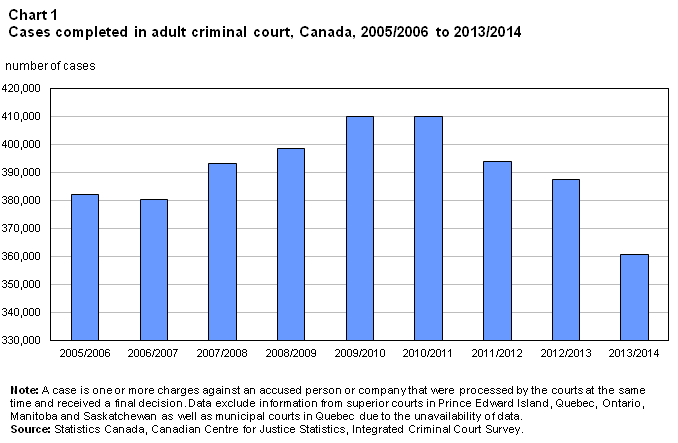
The decrease from the previous year in the number of completed adult criminal court cases occurred throughout most of the country in 2013/2014. Quebec demonstrated the largest decline (-15%) in the number of cases, followed by British Columbia (-9%) and Prince Edward Island (-8%) (Table 2). In contrast, Yukon had an increase in the number of completed cases (+6%), while completed cases in Manitoba (0%) and Alberta (+1%) remained relatively stable.Note 4
Text box 1
Administration of justice practices and statistical trends
In Canada, the creation of criminal law legislation is of federal jurisdiction, while the provinces are responsible for administering this legislation. Both the creation and administration of legislation are likely to affect the workload and operations in Canada’s criminal courts.
The federal, provincial and territorial governments are working together to identify and establish best practices to improve the efficiency of the Canadian justice system. Over the years, the different levels of government have put forward a variety of initiatives that influence the volume of cases and the processing of those cases before the courts.
Below are four examples of the many initiatives that may impact the workload and processing of cases before the country’s courts:
- Fair and Efficient Criminal Trials Act (federal)
- Court-supervised drug treatment program (Quebec)
- Justice on Target Strategy (Ontario)
- Motor Vehicle Act (British Columbia)
The statistical trends presented in this report reflect the progress made in implementing all of these practices and initiatives and are based on standardized reporting rules established with Statistics Canada’s various partners. However, it is impossible to identify a specific initiative as the source of the changes observed in the statistical trends; rather, the trends reflect the results of these initiatives combined.
Most completed adult criminal court cases involve non-violent offences
In 2013/2014, most cases that were completed in adult criminal court involved non-violent offences.Note 5 This pattern has been consistent over time, and is also consistent with police-reported crime statistics that show that most criminal incidents involve non-violent offences (Boyce 2015). In 2013/2014, more than three quarters (76%) of all cases completed in adult criminal court involved non-violent crime, which included property offences (23%), administration of justice offences (23%), Criminal Code traffic offences (13%), other non-violent Criminal Code offences (4%) and other federal statute offences (13%) (Table 3). The remaining 24% of completed cases involved violent offences.
Similar to previous years, ten offence types represented almost 70% of all cases completed in adult criminal court in 2013/2014. Impaired driving was the most common offence, representing 11% of all cases (Chart 2). This was closely followed by theft (10%), failure to comply with a court order (10%) and common assault (9%).
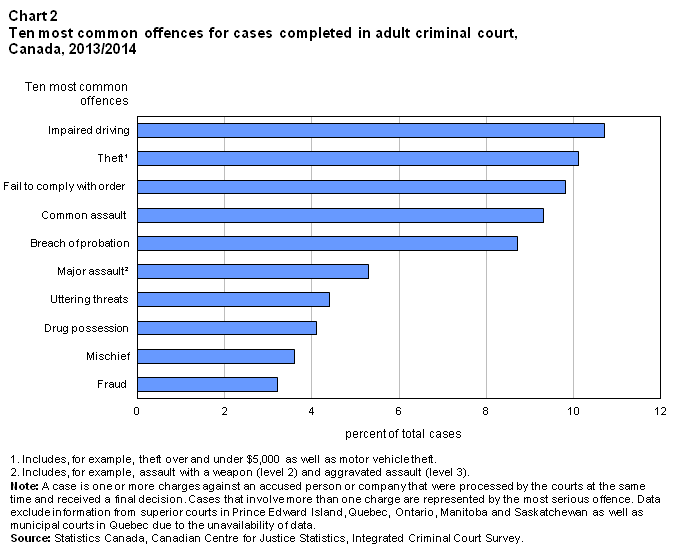
Between 2012/2013 and 2013/2014, most types of cases involving violent crime decreased. Violent crime cases overall decreased by 7%, with the largest decreases occurring in robbery (-15%), uttering threats (-10%) and other violent offencesNote 6 (-10%) cases. In contrast, violent crime cases involving attempted murder (+28%) and homicideNote 7 (+6%) increased in 2013/2014, while criminal harassment cases (+1%) remained relatively stable.
All cases involving property offences decreased in 2013/2014. The largest decreases occurred within break and enter (-12%), other property offencesNote 8 (-11%), and theft (-8%) cases.
Administration of justice offences continued to represent more than 1 in 5 cases (23%) completed in adult criminal court in 2013/2014. This category of offences, which includes offences such as failure to appear in court and breach of probation, gradually increased between 2005/2006 and 2010/2011. Beginning in 2011/2012, the number of cases involving administration of justice offences began to decline. This offence type decreased by 4% in 2013/2014.Note 9
Within the Canadian Criminal Code, there are certain offences which carry mandatory minimum sentences for accused persons who are found guilty.Note 10 In 2013/2014, there were 41,258 cases involving offences which carry a mandatory minimum sentence, representing a decrease (-7%) from the previous year.Note 11 Most of these cases involved impaired driving (92%). The remaining cases were distributed between violent crime offences (6%), and other Criminal Code offences such as weapons (1%) and prostitution (1%).
Majority of adult court cases involve young adults
In 2013/2014, accused persons under the age of 35 represented almost 60% of all individuals appearing in adult criminal court (Chart 3).Note 12 This age group represented a similar proportion (65%) of accused persons in police reported crime statistics in 2013/2014.Note 13 Yet, this same age group represented 29% of the total adult population in 2013.Note 14, Note 15 Between 2000/2001 and 2011/2012, those aged 18 to 24 represented the largest proportion of accused persons appearing in adult criminal court.Note 16 However, beginning in 2012/2013, there was a slight shift in the distribution of ages and those aged 25 to 34 accounted for the largest proportion of accused persons. This continued in 2013/2014, when those aged 25 to 34 accounted for 30% of accused persons appearing in adult criminal court, and those aged 18 to 24 represented a slightly smaller proportion (28%) of accused.
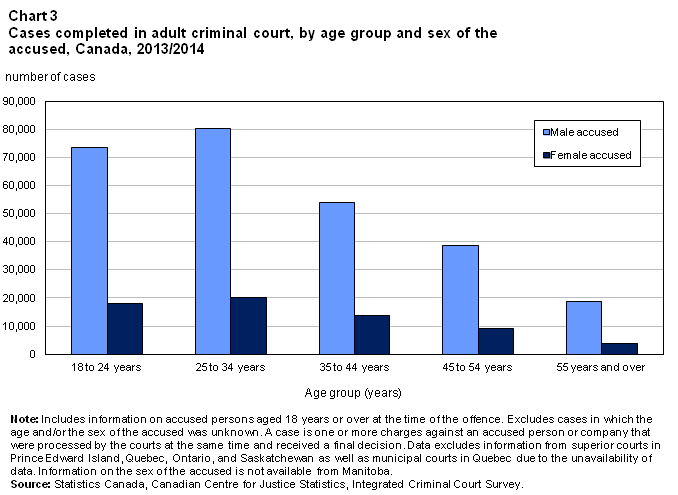
There were some types of adult criminal court cases, particularly some of the most violent ones, for which young adults were more represented than other age groups. For example, young adults under the age of 35 accounted for a larger proportion of the accused in cases of robbery (79%) and homicide (71%) in 2013/2014.
Males represented the majority (80%) of accused persons appearing in adult criminal court, while females represented a much smaller proportion (20%) in 2013/2014 (Table 4). Men represented a substantially higher proportion of accused persons in violent crime cases, such as sexual assault (99%), other sexual offences (97%) and robbery (89%). When women accused were before the courts, it was most frequently in relation to non-violent crime such as theft (35%) and fraud (33%).
Almost two thirds of all completed adult cases result in finding of guilt
Cases completed in adult criminal court typically result in one of three types of decisions. The most common outcome is a finding of guilt. In addition to a finding of guilt imposed by the court, this category includes guilty pleas, and cases where an absolute or conditional discharge has been imposed.Note 17 Cases may also be stopped or interrupted for a variety of reasons (e.g., lack of sufficient evidence or referral to an alternative measures program), resulting in charges being stayed (suspended for up to one year), withdrawn, dismissed or discharged. Lastly, cases may result in an acquittal, in which the accused is found not guilty of the charges presented before the court.Note 18
In 2013/2014, 63% of all cases completed in adult criminal court resulted in a finding of guilt. This proportion has remained relatively stable over the past ten years. In 2013/2014, 32% of all completed cases were stayed or withdrawn, and 4% of cases were acquitted. The remaining 1% of completed cases resulted in another type of decision, such as the accused was found not criminally responsible on account of mental disorder (Table 5).Note 19, Note 20
The proportion of cases resulting in a guilty finding varies throughout the country. In 2013/2014, the highest proportion of guilty findings for cases completed in adult criminal court was in Prince Edward Island (78%) (Chart 4). The lowest proportion of such cases was in Ontario (55%).
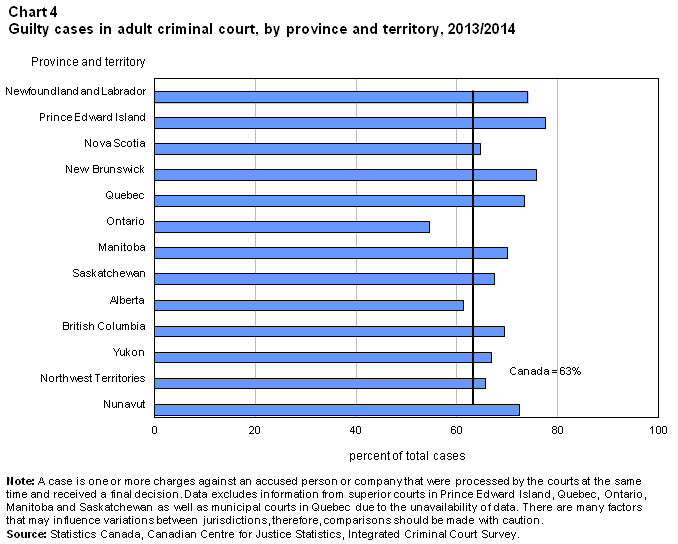
Variations in court decisions among the provinces and territories may be affected by the use of pre-charge screening. Pre-charge screening refers to a formal process whereby a Crown prosecutor (as opposed to police) determines whether a criminal charge is laid and proceeds to court (Public Prosecution Service of Canada 2014). Pre-charge screening systems are currently in place in New Brunswick, Quebec and British Columbia, where the proportions of guilty findings were among the highest in the country in 2013/2014.
Another factor that may also impact the decision reached in criminal court is plea negotiations, or “plea bargaining”. Plea negotiations involve an agreement between the accused and the prosecutor, wherein the accused pleads guilty in exchange for the prosecutor agreeing to take a particular course of action (Verdun-Jones 2012). These agreements may touch on the nature of the charges, the sentence, or the facts that may be presented in court. The extent to which plea negotiations are utilized in Canada currently remains unknown.
Cases involving violent offences result in guilty finding less often than non-violent cases
In 2013/2014, cases completed in adult criminal court involving violent offences resulted in a finding of guilt less often than property offences and administration of justice offences (50% versus 59% and 72%, respectively) (Table 5).
However, the types of decisions reached by the courts varied considerably by the specific type of offence. For example, in 2013/2014, among violent offences, 59% of robbery cases resulted in a guilty finding, while this was the finding in 20% of attempted murder cases. The majority of attempted murder cases resulted in a decision of stayed/withdrawn (65%).
The administration of justice category of cases also showed similar variation among specific offence types. Failure to appear in court resulted in a finding of guilt in 46% of cases, while the proportion was almost double in unlawfully at large cases (83%).
Probation most common sentence imposed in adult criminal court
Judges are responsible for determining the appropriate sentence for accused persons who are found guilty of a criminal offence. In doing so, they must consider the key principles of sentencing, as well as weigh various factors associated with the incident such as the gravity of offence, the amount of harm inflicted upon the victim(s), as well as the criminal history of the accused (Department of Justice 2005).
In 2013/2014, probation continued to be the most common type of sentence imposed in adult criminal court cases, either on its own or in combination with another type of sentence, at 43% of all guilty cases (Table 6). A probation sentence requires the offender to remain in the community and be subject to particular conditions, such as keeping the peace and appearing in court as required. In 2013/2014, the median length of probation in Canada was 365 days (1 year) (Chart 5).
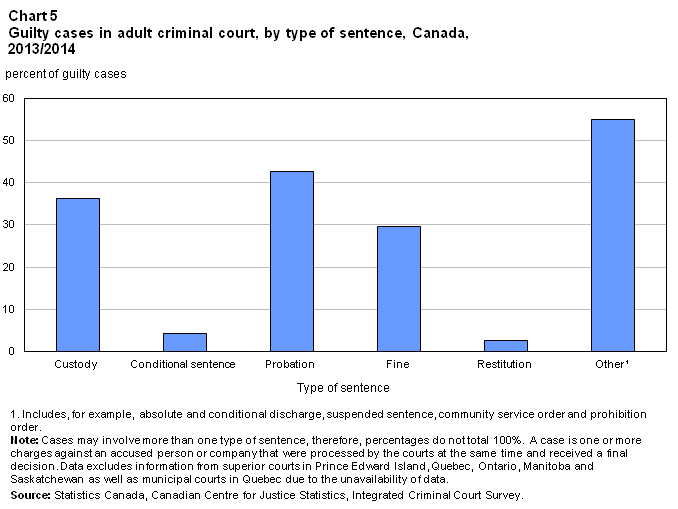
A fine was imposed in 30% of adult criminal court cases in 2013/2014. In general, fines can range from small amounts for less serious offences, to large amounts for more serious offences. In 2013/2014, the median amount of fine imposed was $600.
Most custody sentences less than 6 months
In 2013/2014, custodial sentences were imposed in just over one third (36%) of guilty adult criminal court cases (Table 6). In 2013/2014, 87% of individuals sentenced to custody received a sentence of six months or less (Chart 6).Note 21 Only about 3% of individuals received a sentence of two years or more. The median length of a custodial sentence in 2013/2014 was 30 days (1 month).Note 22
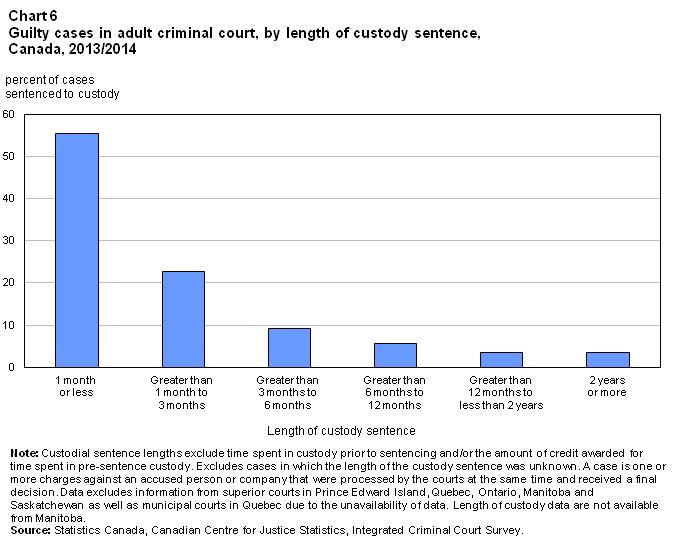
The proportion of completed cases that receive a sentence of custody varies across the provinces and territories. In 2013/2014, Prince Edward Island (62%) imposed custodial sentences at a considerably higher proportion than the rest of Canada (36%) (Chart 7). In contrast, the lowest proportions of custody sentences were found in New Brunswick (28%), Nova Scotia (29%) and Newfoundland and Labrador (32%).
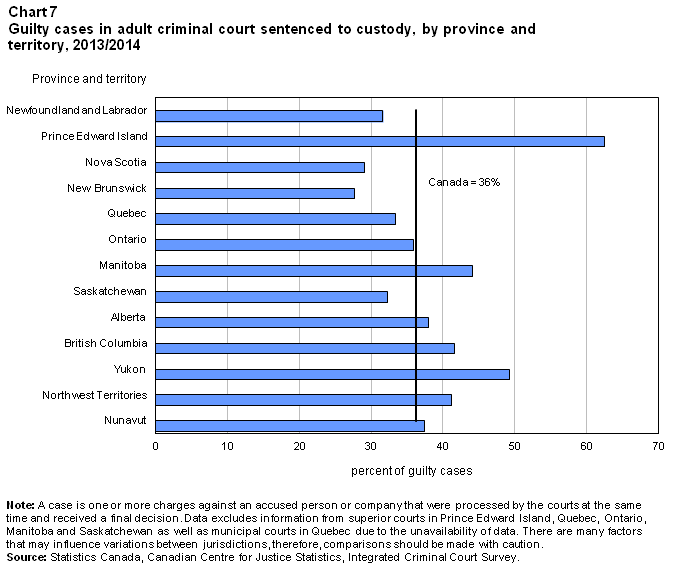
Similar to previous years, the main reason for the high proportion of custodial sentences in Prince Edward Island relates to cases of impaired driving.Note 23 In that province, courts imposed a custodial sentence in the majority (87%) of all impaired driving cases in 2013/2014. In contrast, when looking at Canada as a whole, 9% of all impaired driving cases were sentenced to custody.
Case processing times increase
The Canadian Charter of Rights and Freedoms outlines that an accused person has a fundamental right to be brought to trial in a timely manner.Note 24 While the Charter does not indicate a specific time limit that is required in criminal court cases, case law indicates that an 8 to 10 month period is considered to be a reasonable amount of time to be brought to trial. This has been affirmed by a number of Supreme Court rulings, such as R. v. Askov [1990]Note 25 and R. v. Morin [1992].Note 26
In 2013/2014, the median amount of time from an individual’s first court appearance to the completion of their case was 123 days (around 4 months), a slight increase from the years prior. The median number of court appearances it took to complete a case was 5.
Similar to previous years, Prince Edward Island had the shortest median case elapsed time, at 37 days, and Quebec had the longest, at 238 days (Table 2; Chart 8). Northwest Territories had the shortest median number of appearances in a case, at 2 appearances, while Manitoba and British Columbia had the longest, at 7 appearances.

Cases involving more serious offences or multiple charges often take longer than others to complete. In 2013/2014, homicide cases took the longest to complete and were the only offence type with a median length longer than one year (451 days). This was followed by sexual assault cases (321 days), and attempted murder cases (314 days) (Table 3). Similarly, cases that involved multiple charges took much longer to complete than those that involved single charges (155 days and 87 days, respectively).Note 27
Research has also demonstrated that there are several other factors that are often associated with longer case lengths, such as trial cases and those involving bench warrants. Cases involving a trial often require a lot of time and resources to hear all of the evidence, as well as the testimony of the witnesses and victim impact statements (Department of Justice Canada 2015). Cases involving bench warrants, in which the court issues a warrant of arrest for an accused person who fails to appear in court, also tend to be slowed by the delays resulting from having to re-apprehend an accused person (Thomas 2010).
Completed adult criminal court cases in 2013/2014 at a glance
Survey description
The Integrated Criminal Court Survey (ICCS) is administered by the Canadian Centre for Justice Statistics (Statistics Canada) in collaboration with provincial and territorial government departments responsible for criminal courts in Canada. The survey collects statistical information on adult and youth court cases involving Criminal Code and other federal statute offences. Data contained in this article represent the adult criminal court portion of the survey, namely, individuals who were 18 years of age or older at the time of the offence.
The primary unit of analysis is a case. A case is defined as one or more charges against an accused person or company that were processed by the courts at the same time and received a final decision. A case combines all charges against the same person having one or more key overlapping dates (date of offence, date of initiation, date of first appearance, or date of decision) into a single case.
A case that has more than one charge is represented by the charge with the "most serious offence" (MSO). The most serious offence is selected using the following rules. First, court decisions are considered and the charge with the “most serious decision” (MSD) is selected. Court decisions for each charge in a case are ranked from most to least serious as follows: (1) guilty, (2) guilty of a lesser offence, (3) acquitted, (4) stay of proceeding, (5) withdrawn, dismissed or discharged, (6) not criminally responsible, (7) other, and (8) transfer of court jurisdiction.
Second, in cases where two or more charges result in the same MSD (e.g., guilty), Criminal Code sentences are considered. The charge with the most serious offence type is selected according to an offence seriousness scale, based on actual sentences handed down by courts in Canada.Note 28 Each offence type is ranked by looking at (1) the proportion of guilty charges where custody was imposed and (2) the average (mean) length of custody for the specific type of offence. These values are multiplied together to arrive at the final seriousness ranking for each type of offence. If, after looking at the offence seriousness scale, two or more charges remain tied then information about the sentence type and duration of the sentence are considered (e.g., custody and length of custody, then probation and length of probation, etc.).
In 2013/2014, ICCS coverage reflected all cases completed in adult Canadian criminal courts, with the exception of superior courts in Prince Edward Island, Quebec, Ontario, Manitoba and Saskatchewan as well as municipal courts in Quebec. This data was not available for extraction from their electronic reporting systems and was therefore not reported to the survey.
The absence of data from superior courts in these five jurisdictions may have resulted in an underestimation of the severity of sentences since some of the most serious cases, which are likely to result in the most severe sentences, are processed in superior courts. There may also be an underestimation of case elapsed times as more serious cases generally require more court appearances and take more time to complete.
Cases are counted according to the fiscal year in which they are completed. Each year, the ICCS database is considered final at the end of March for the production of court statistics pertaining to the preceding fiscal year. However, these counts do not include cases that were pending an outcome at the end of the reference period. If a pending outcome is reached in the next fiscal year, then these cases are included in the completed case counts for that fiscal year. However, if a one-year period of inactivity elapses, then these cases are deemed complete and the originally published counts for the previous fiscal year are subsequently updated and reported in the next year’s release of the data. Historically, updates to a previous year’s counts have resulted in an increase of about 2%.
Detailed data tables
Table 1 Charges and cases completed in adult criminal court, Canada, 2005/2006 to 2013/2014
Table 2 Cases completed in adult criminal court, by province and territory, 2012/2013 and 2013/2014
Table 3 Cases completed in adult criminal court, by type of offence, Canada, 2012/2013 and 2013/2014
Table 5 Cases completed in adult criminal court, by type of offence and decision, Canada, 2013/2014
References
Alam, S. 2015. “Youth court statistics in Canada, 2013/2014.” Juristat. Statistics Canada Catalogue no. 85-002-X.
Boyce, J. 2015. “Police-reported crime statistics in Canada, 2014.” Juristat. Statistics Canada Catalogue no. 85-002-X.
Burczycka, M. and C. Munch. 2015. “Trends in offences against the administration of justice, 2014.” Juristat. Statistics Canada Catalogue no. 85-002-X (Forthcoming in Fall, 2015).
Dandurand, Y., K. Kittayarak and A. MacPhail. 2015. Justice Indicators and the Criminal Justice Reform: A Reference Tool. International Centre for Criminal Law Reform and Criminal Justice Policy. Vancouver, British Columbia.
Department of Justice Canada. 2005. Backgrounder: Fair and Effective Sentencing – A Canadian Approach to Sentencing Policy. (accessed April 8, 2015).
Department of Justice Canada. 2015. Canada’s System of Justice. Catalogue no. J2-128/2015. (accessed February 27, 2015).
Miladinovic, Z. and J. Lukassen. 2014. “Verdicts of not criminally responsible on account of mental disorder in adult criminal courts, 2005/2006-2011/2012.” Juristat. Statistics Canada Catalogue no. 85-002-X.
Perreault, S. 2013. “Impaired driving in Canada, 2011.” Juristat. Statistics Canada Catalogue no. 85-002-X.
Public Prosecution Service of Canada. 2014. Public Prosecution Service of Canada Deskbook. Catalogue no. J79-2/2014E. (accessed June 11, 2015).
Thomas, J. 2010. "Adult criminal court statistics, 2008/2009." Juristat. Vol. 30, no. 2. Statistics Canada Catalogue no. 85-002-X.
United Nations Office on Drugs and Crime. 2006. “Cross cutting issues: Criminal Justice information.” Criminal Justice Assessment Toolkit. Vienna, Austria.
Verdun-Jones, S. 2012. "Plea bargaining." Criminal Justice in Canada. 4th edition. Julian V. Roberts and Michelle G. Grossman (eds). Toronto, Ontario.
Notes
- Date modified:
